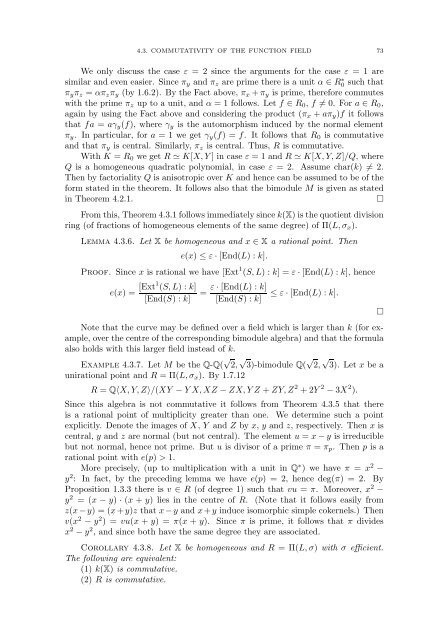MEMOIRS
MEMOIRS
MEMOIRS
- No tags were found...
Create successful ePaper yourself
Turn your PDF publications into a flip-book with our unique Google optimized e-Paper software.
4.3. COMMUTATIVITY OF THE FUNCTION FIELD 73We only discuss the case ε = 2 since the arguments for the case ε =1aresimilar and even easier. Since π y and π z are prime there is a unit α ∈ R0 ∗ such thatπ y π z = απ z π y (by 1.6.2). By the Fact above, π x + π y is prime, therefore commuteswith the prime π z up to a unit, and α = 1 follows. Let f ∈ R 0 , f ≠0. Fora ∈ R 0 ,again by using the Fact above and considering the product (π x + aπ y )f it followsthat fa = aγ y (f), where γ y is the automorphism induced by the normal elementπ y . In particular, for a =1wegetγ y (f) =f. It follows that R 0 is commutativeand that π y is central. Similarly, π z is central. Thus, R is commutative.With K = R 0 we get R ≃ K[X, Y ]incaseε =1andR ≃ K[X, Y, Z]/Q, whereQ is a homogeneous quadratic polynomial, in case ε = 2. Assume char(k) ≠2.Then by factoriality Q is anisotropic over K and hence can be assumed to be of theform stated in the theorem. It follows also that the bimodule M is given as statedin Theorem 4.2.1.□From this, Theorem 4.3.1 follows immediately since k(X) is the quotient divisionring (of fractions of homogeneous elements of the same degree) of Π(L, σ x ).Lemma 4.3.6. Let X be homogeneous and x ∈ X a rational point. Thene(x) ≤ ε · [End(L) :k].Proof. Since x is rational we have [Ext 1 (S, L) :k] =ε · [End(L) :k], hencee(x) = [Ext1 (S, L) :k][End(S) :k]=ε · [End(L) :k][End(S) :k]≤ ε · [End(L) :k].□Note that the curve may be defined over a field which is larger than k (for example,over the centre of the corresponding bimodule algebra) and that the formulaalso holds with this larger field instead of k.Example 4.3.7. Let M be the Q-Q( √ 2, √ 3)-bimodule Q( √ 2, √ 3). Let x be aunirational point and R =Π(L, σ x ). By 1.7.12R = Q〈X, Y, Z〉/(XY − YX,XZ− ZX,Y Z + ZY,Z 2 +2Y 2 − 3X 2 ).Since this algebra is not commutative it follows from Theorem 4.3.5 that thereis a rational point of multiplicity greater than one. We determine such a pointexplicitly. Denote the images of X, Y and Z by x, y and z, respectively. Then x iscentral, y and z are normal (but not central). The element u = x − y is irreduciblebut not normal, hence not prime. But u is divisor of a prime π = π p .Thenp is arational point with e(p) > 1.More precisely, (up to multiplication with a unit in Q ∗ )wehaveπ = x 2 −y 2 : In fact, by the preceding lemma we have e(p) = 2, hence deg(π) =2. ByProposition 1.3.3 there is v ∈ R (of degree 1) such that vu = π. Moreover, x 2 −y 2 =(x − y) · (x + y) lies in the centre of R. (Note that it follows easily fromz(x − y) =(x + y)z that x − y and x + y induce isomorphic simple cokernels.) Thenv(x 2 − y 2 )=vu(x + y) =π(x + y). Since π is prime, it follows that π dividesx 2 − y 2 , and since both have the same degree they are associated.Corollary 4.3.8. Let X be homogeneous and R =Π(L, σ) with σ efficient.The following are equivalent:(1) k(X) is commutative.(2) R is commutative.
















